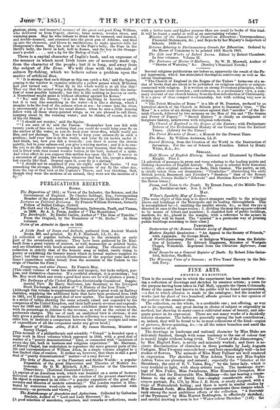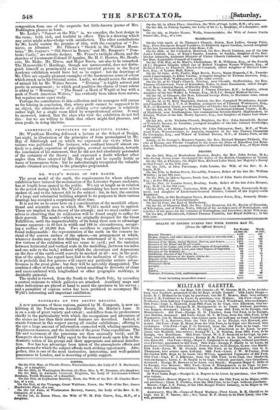FINE ARTS.
AMATEUR EXHIBITION.
THIS is the second year in which the experiment has been made of form- ing a collection of drawings and sketches by amateur artists ; a room for the purpose having been taken in Pall Mall, opposite the Opera Colonnade. Some of the names best known to the public will be found unrep —a fact to which allusion is made in the catalogue; but the num:etre:1 works (not far short of two hundred) affords ground for a fair opinion of the powers of the amateur class.
The collection, on the whole, is a creditable one ; not offering, as was not to be expected, any great daring in choice of subject or originality in method, but showing in many cases a cultivated sense of beauty, and ade-
quate power in its expression. There are not many works of a decidedly inferior character. The ladies are generally among the best contributors;
as, indeed, they will be found to be inmost collections of the kind—copies of pictures, flower-painting, &c.—in all the minor branches and amid the minor votaries of art.
The drawings in landscape and national character by Miss Blake are delicately finished, though with some tendency to the use of colour that
is merely bright without being vivid. The Court of the Abencerrages," by Mrs. Higford Burr, is nicely and minutely worked; and there is se- curate discrimination of character in three portraits by Lady Augusta Cadogan. Miss Twopeny succeeds best—andhere exceedingly well—in her studies of flowers. The animals of Miss Mary Palliser are well rendered in expression. The sketches by Miss Ashton Yates and Miss Sophia Ashton Yates are pleasing and natural; especially the " Interior at the
Shrubbery, the seat of R. V. Yates, Esq.," by the latter lady, which is very truthful in light, with sharp artistic touch. The landscape draw- ings of Mrs. Puller, Miss Swinburne, -Miss Henrietta Crompton, Miss
Beckford, and the Honourable Mrs. Mildmay—the last bearing a resem• blance to the -style of David Cox—display considerable skill. The
crayon portrait, No. L79, by Miss J. E. Scott, is nicely designed, with a tinge of Mulreadyish feeling; and there is merit in similar studies by Mies Hannah Scott. Miss Elizabeth Carroontributes three designs which rank among the most ambitious efforts of the collection. "A Souvenir -of the Pyrenees," by Miss Harriet Rodilington, is effectively sketched; and careful drawing is seen in her "Water-colour Sketches" (149) : the -
composition from one of the exquisite but little-known 'poems of Mrs. Boddington pleases us least. Mr. Leslie's "Sunset on the Nile" is, we consider, the best design in the room; bold, rich, and truthful in effect. This is a drawing which any artist might acknowledge with satisfaction. The other contributions by Mr. Leslie sustain the promise of this, with the exception of " De- metre, an Albanian." Mr. Pilleau's " Sketch in the Wicklow Moun- tains," Mr. Jenyns's " Old Street in Rouen," and Mr. Burgess's " Pem- broke Castle," are artistic designs. Mr. Fraser's twilight effects, and the sketches of Lieutenant-Colonel D'Aguilar, Mr. H. C. Herries, Mr. Heath- cote, Mr. Blake, Mr. Elwes, and Major Baron, are also to be remarked. The Honourable C. Hardinge, though not unsuccessful, does not distin- guish himself so prominently as his very talented picture in the Royal Academy exhibition would have led us to expect : but the drawings of Mr. Clive are equally pleasant examples of the harmonious sense of colour which struck us in his Oriental series. Lastly, we should notice the studies of animal life by Mr. Walter Severn. " Evening" is highly natural and poetic in arrangement ; to which good qualities the charm of truer colour is added in " Morning." " The Stand—a Herd of Wapiti at bay with a pack of North American Wolves," has evidently been taken from nature, but requires more exact study.
Perhaps the contributors to this collection and its managers will excuse us for hinting in conclusion, that, where profit cannot be supposed to be an object, the admission-fee of a shilling extra catalogue is relatively rather high for a single room filled by nonprofessional artists. It may be answered, indeed, that the class who visit the exhibition do not feel this : but we are willing to think that others might find pleasure, and even profit, in doing likewise.



























 Previous page
Previous page